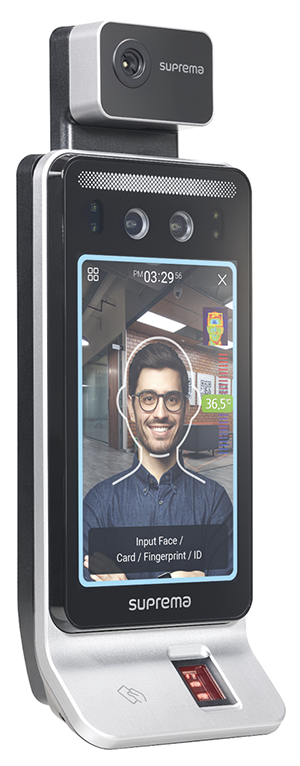

Before the Coronavirus changed everything, biometric identification was already being broadly adopted in the residential estate market as a convenient access control mechanism. At that stage, fingerprint biometrics was the modality chosen because of its convenience and ease of use.
Of course, there were always those who could not have their fingerprints read, but as the minority of people (except, perhaps in retirement villages), they were viewed as more of an inconvenience rather than a reason not to use biometrics.
Then COVID-19 struck and things got a bit complicated when it came to touching public surfaces, such as a fingerprint biometric sensor. Some estates made the decision to just stick it out and maintain some form of sanitising process, others either reverted to card or other access methods that would not require touching public surfaces (and some patted themselves on the back for staying with these access solutions in the first place), while others took a leap forward to facial recognition biometrics. We won’t mention those who still retained and retain the visitor book, which at best was a mess, at worst was touched by everyone and soon will be the focal point of POPIA complaints. Naturally, companies with touchless fingerprint (or any touchless biometric) technologies saw this as an opportunity.
Having passed through lockdowns and waves of the virus, Hi-Tech Security Solutions thought it would be interesting to see what is happening in estates when it comes to biometric access and to see what the various vendors have available right now. We start by asking how biometric use has developed in this market.
Still a growth market
Nicolas Garcia, sales director (Biometric Terminals), Middle East and Africa at IDEMIA says there has been a growing demand for biometric terminals and in particular for contactless biometric technologies due to the ongoing pandemic. “Besides the traditional advantages of contact biometrics, such as security and convenience, contactless biometrics improves recognition performance and brings a higher level of hygiene to the equation.”
He provides the example of IDEMIA’s MorphoWave, which scans four fingerprints instead of one in a 1-second contactless hand wave. The device records advanced 3D images of the fingerprints, which has proved even more reliable thanks to the incorporation of AI (artificial intelligence) in the company’s technology.
Jason Zhong, product and solutions director, Dahua Technology note that traditional fingerprint biometrics is not the way to go anymore due to health concerns as well as the danger that inferior (cheaper) devices can be easily fooled with fake fingerprints.
Mpho Radiokana, sales manager for Suprema SA believes there is no going back to card, fob or even remote control technology in estates for a number of reasons, one of which is the ease of copying them or ‘lending’ them to unauthorised people.
“While there may still be fingerprint sensors out there that aren’t suitable for all fingerprint qualities, this should not present a problem for most users if you invest in biometric products from reputable biometric sensor manufacturers that advance their products to ensure that their sensors are robust and capable of scanning fingerprints in varied abnormal circumstances.”


He adds that Suprema continually works to make sure its biometric sensors are not only reliable, but are also in full compliance with international regulatory bodies and compliance standards, such as FBI PIV, FBI Mobile IF FAP20, NIST and WSQ). Suprema makes use of advanced fingerprint algorithms for improved accuracy as well as technology such as adaptive gain control, distortion compensation and noise reduction for reduced capture error rates in various environments.
“Suprema’s facial recognition solutions are becoming even more popular now with residential estates looking for contactless solutions,” Radiokana adds.
“We provide a highly adaptable solution by supporting multiple authentication methods in the same access control unit,” says Alex Penhaligon, project sales manager at Hikvision SA. “For example, our MinMoe terminal supports card authentication, facial recognition and also fingerprint authentication in some models, all in one unit. People can choose the most appropriate access authentication methods according to different needs, while at the same time we try to make product selection easier for integrators and installers by combining commonly-used authentication modes in one unit.”
Is facial biometrics the silver bullet?
Although there are numerous cases of estates adopting facial recognition in light of the pandemic, one has to ask if the recognition capabilities of the technology is good enough? Using it for access at the gate will require solutions that operate in varying light conditions, see faces at different angles and perhaps even through car windows for those residents who wish to be difficult.
Radiokana notes that most facial recognition readers can authenticate people at distances of between 1 m to 3 m, but you also need to consider that not all devices are suited to outdoor installation.
“Suprema’s FaceStation F2, with IP65 certification, can be used outdoors and it has a proven track record for being suitable for all ethnicities,” he says. “It features infrared LEDs and a white light LED strip that assists with illuminating the subject presented to the reader. The greatest challenge when it comes to lighting, however, is not so much a dark environment but rather installation locations with too much light, be it natural or artificial. Lighting is very important for the reader to be able to calibrate itself to correctly extract the person’s facial features, match them with an existing user in the database and correctly grant access.”
However, he adds that the benefits of using facial, non-contact devices vastly outweigh the challenges that may be experienced during the initial set-up phase.
Garcia explains that IDEMIA’s VisionPass has attracted attention from estates. “VisionPass is IP65 certified, which means that it fits both indoor and outdoor purposes, and it comes supercharged with different technologies to ensure accurate identification of people within a wide range of uncontrolled conditions such as light, darkness and weather. VisionPass algorithms also ensure that it only identifies the person who intended to use the system. In case of estates, it makes sure that it does not open the gate in the first lane if the authorised user is trying to access in the second lane.”
Accuracy of recognition is not something that is an issue any longer with the addition of AI to many devices, says Penhaligon. “For example, the accuracy of our latest models can be over 99%, and the verification speed is under 0.2 s, with a 3 m recognition distance.
“Apart from that, with well-designed features and mechanisms, users can get a more reliable facial access solution with features such as a facial image capture quality check at the time of enrolment to make sure the profile quality is sufficient. The devices can also supplement lighting when required.
Zhong simply states, “We have too many practical cases to prove that the convenience of face recognition, and the use of solutions for a variety of scenarios are very mature.”
The question of privacy
Whether it is in this publication or many others, readers will by now be tired of reading about the imminent reality of the Protection of Personal Information ACT (POPIA). When it comes to biometrics, especially facial recognition, you don’t get information that is much more personal and that should be subject to stringent protection rules.
Penhaligon affirms that Hikvision is committed to protecting personal data and has been taking several initiatives to protect personal data in the use of its products and solutions, such as communication encryption through AES algorithms and the HTTPS protocol, minimised data collection, data anonymisation, user authorised data collection, data security audits and more.
“In data transmission, encrypted interfaces from the cloud to the client and devices guarantee communication security. In data storage, server-side encryption is another safeguard for data security.”
From a Suprema perspective, Radiokana confirms that cybersecurity and data protection are at the centre of Suprema technologies, “especially those products such as our BioStar 2 security management platform and all hardware used along with it. Suprema has recently advanced its level of security to ensure that data is processed and exchanged in compliance with GDPR (the EU’s General Data Protection Regulation) and kept in a compliant method while on the server, on the readers themselves as well as while in transit between server and connected readers.”
To this end all data is encrypted using AES 256, AES 128, DES/3DES before actually storing it on the server, on devices or cards. In addition, Suprema’s web based security platform BioStar 2 has achieved ISO 27001 and 27701 certifications, satisfying international standards for data protection and management. Even for serial communication through RS-485, Suprema has encrypted this using AES 128.

Privacy is also a concern for IDEMIA and, through its European operation, is subject to very tight privacy regulations (GDPR). “Irrespective of which biometric modalities are used, our system always works on the same sound principle,” states Garcia. “IDEMIA neither stores nor has access to any data on any site where the system runs. The algorithm only processes original pictures to generate encrypted templates and destroys the pictures automatically after use.
“By its very design, it cannot be reverse-engineered to the original picture. The whole system enables the use of encryption and security features, from the enrolment reader to the computer, and from the computer to the readers and servers. Within the limits of regulations, each piece of information captured by the operator (biometrics, name, surname, date of birth, etc.) can be modified or removed upon request by any individual. This ensures individuals always have complete control about how their personal data is used.”
Playing nicely with others
When it comes to biometric installations, as with all security systems on estates and elsewhere, the ability of products to integrate with third-party systems is key to a successful security solution. However, integration is not simple in all cases, as companies often want to lock users into only using their own products.
Zhong says that while Dahua has its own overall solutions that include a variety of products, including front-end acquisition devices, back-end storage devices and software applications, the company has a number of partners around the world that integrate Dahua technology into other systems.
Suprema BioStar 2 is a web-based, open and integrated security platform where integration is based on REST APIs, and SDK-based (software development kit) hardware integration is possible through the BioStar 2 API, BioStar 2 Device SDK and Suprema G-SDK. This allows system integrators to integrate Suprema hardware directly into their platform or to integrate with BioStar 2 where there is no need to integrate with the hardware.
Integration is one of IDEMIA’s strengths, according to Garcia. “Our technology is completely interoperable, modular and able to integrate with other devices in different use cases.”
The company offers two levels of integration. One through a standard SDK that partners can use to integrate readers to their solutions. The second one is BioBridge, an in-house middleware designed to synchronise third-party systems with MorphoManager, its biometric readers’ management software. In this case, our partners focus on what they do best and we concentrate on the biometric part of the system.
Hikvision provides various integration choices for different application purposes, from physical wire connections to be used as a biometric reader, for example on top of pre-existing turnstiles, to product-level and system-level API integration.
Solutions for estates
As is our norm, we asked our respondents to briefly mention what products and solutions they have specifically aimed at the residential estate market.
While Dahua also includes security for regulations such as the GDPR, Zhong says it has developed AI solutions specifically for its technology to enhance their performance (such as people and vehicle management solutions, among others) and makes use of an open API to allow integration with other systems that may not be supported by its partners. Its solutions range from integrated systems for individual homes to systems to manage the security and wellbeing on large estates.
Hikvision provides a comprehensive building security solution, from video security through to vehicle and personnel management says Penhaligon. These include:
• Highly efficient management.
• Convenient parking experiences.
• Paperless, digitised visitor management.
• Enhanced protection for outdoor surroundings.
“All Hikvision subsystem components are designed to be highly automated, AI-empowered and all managed in a unified platform with interoperability and powerful, visualised management tools and dashboards, all providing enhanced security, boosting operation efficiency and improving visitors’ experience.”
“While we continue to propose our contact range solution, our current focus is clearly on the contactless solutions,” notes IDEMIA’s Garcia. “We licence to our partners and customers and we continue to enhance our MorphoWave and VisionPass offering accordingly with new features, pushing performance even higher to ensure the best possible end-user experience.
“In addition, we are completing our range of contactless solutions with Augmented Vision, our video analytics solution that piggy-backs on existing CCTV cameras and can be associated with access control and video management systems. This solution delivers features to enable the protection of people and premises by preventing security incidents, to detect person of interests and boost the efficiency of operators during investigations. Augmented Vision can also be used as an integrated component of an access control solution.”
Suprema offers BioStar 2, which provides comprehensive functionality for access control, time and attendance management, visitor management, and video log maintenance as well as a range of access control readers supporting multiple authentication types, including card, fingerprint, PIN, facial recognition, smartcard, NFC and BLE. “Our latest release is FaceStation F2,” says Radiokana, “Suprema’s first face recognition device for outdoor installation which is very well suited to the current demand for contactless solutions. Suprema also offers a contactless solution to existing sites with fingerprint devices installed via its mobile credentials that allow access using your mobile phone.”
| Tel: | +27 10 593 3242 |
| Email: | [email protected] |
| www: | www.dahuasecurity.com/sa |
| Articles: | More information and articles about Dahua Technology South Africa |
| Tel: | +27 11 543 5800 |
| Email: | [email protected] |
| www: | www.technews.co.za |
| Articles: | More information and articles about Technews Publishing |
| Tel: | +27 10 085 8300 |
| Email: | [email protected] |
| www: | www.hikvision.com/africa/ |
| Articles: | More information and articles about Hikvision South Africa |
| Tel: | +27 11 601 5500 |
| Email: | [email protected] |
| www: | www.idemia.com |
| Articles: | More information and articles about IDEMIA |
| Tel: | +27 11 784 3952 |
| Email: | [email protected] |
| www: | www.suprema.co.za |
| Articles: | More information and articles about Suprema |
© Technews Publishing (Pty) Ltd. | All Rights Reserved.